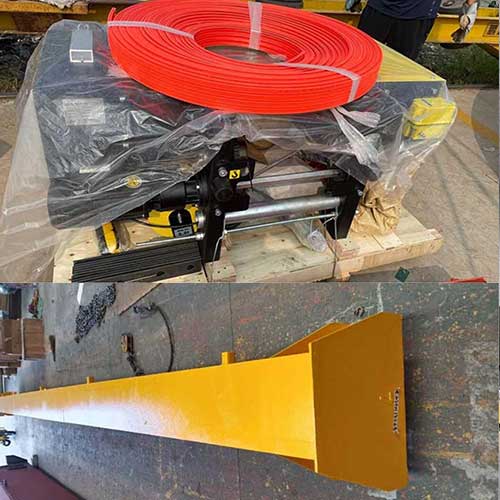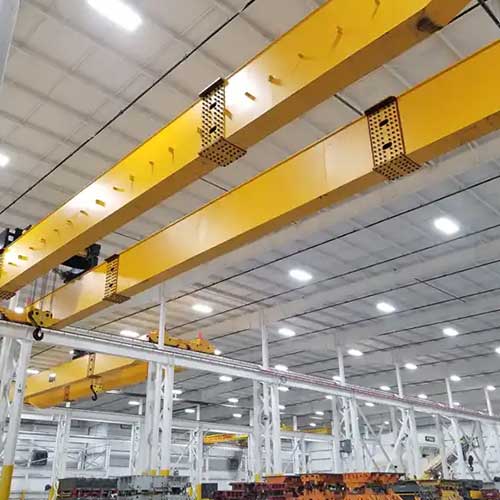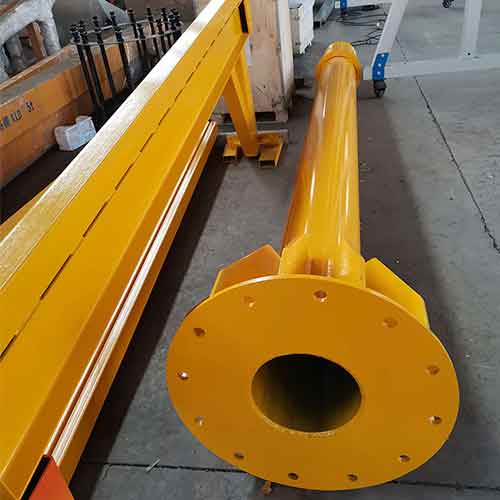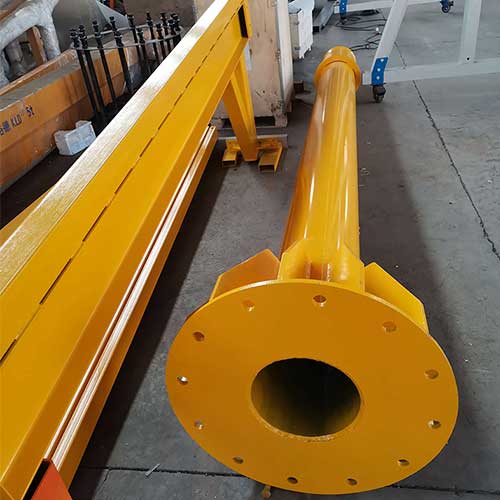5 Ton Single Girder EOT Crane UAE, Cost-Efficiency & ROI Analysis
5 ton single girder eot crane for sale.Tailored 5 ton eot crane projects installed in UAE and cost-efficiency & ROI analysis to get good price eot crane.
| Types | Single girder eot crane |
| Crane Capacity | 5 ton |
| Lifting Height | 4.88 meters |
| Crane Span | 10.24 meters |
| Note | Custom eot cranes are provided. |
Category: EOT Crane UAE
Your Trusted Single Girder EOT Crane Manufacturer & Supplier
5 Ton Single Girder EOT Crane UAE, Cost-Efficiency & ROI Analysis
5 ton single girder eot crane for sale.Tailored 5 ton eot crane projects installed in UAE and cost-efficiency & ROI analysis to get good price eot crane.
Installation of a 5-Ton Single Girder EOT Crane, Cost-Efficiency and ROI Analysis:
In the rapidly developing industrial landscape of the United Arab Emirates (UAE), a prominent manufacturing facility recently undertook a significant project to enhance their material handling capabilities. The project involved the installation of a 5-ton single girder EOT (Electric Overhead Traveling) crane, equipped with European-style electric hoists. This case study highlights the key aspects of this endeavor, including the crane specifications, power supply requirements, and the impact on the facility's operational efficiency.
Crane Types: Single Girder EOT Crane with European Style Electric Hoists
The chosen crane for this project was a single girder EOT crane featuring European style electric hoists. This selection was based on the client's requirement for a crane that offers precise and efficient material handling while adhering to the highest safety and quality standards.
Crane Specifications:
- Capacity:5 tons
- Span:10.24 meters
- Lifting Height:4.88 meters
The 5-ton capacity of the crane ensures that it can efficiently handle heavy loads, making it ideal for various industrial applications. With a span of 10.24 meters, the crane can cover a significant area within the facility, allowing for versatile material handling. The lifting height of 4.88 meters accommodates the vertical requirements of the facility's manufacturing processes, ensuring it can effectively move materials to the desired locations.
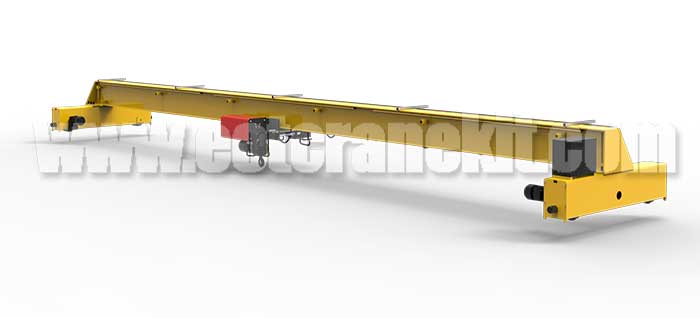

Main girder of 5 ton single girder eot crane

End carriage of 5 ton single girder eot crane

Electric hoist of 5 ton single girder top running eot crane

Electrical box of 5 ton overhead cane for sale UAE
Crane Power Supply:
The 5-ton single girder EOT crane is powered by a reliable and consistent electrical source. It operates on a power supply of 380V, 50Hz, 3-phase, which is commonly available in industrial setups. This power supply configuration ensures that the crane can function without interruptions, contributing to the seamless operation of the facility's production processes.
Project Location: UAE
The installation of this 5-ton single girder EOT crane took place in the United Arab Emirates, an emerging industrial hub in the Middle East. The UAE's strategic geographical location and thriving business environment make it an attractive destination for manufacturing and logistics companies. The project reflects the region's commitment to investing in modern, efficient infrastructure to support the growing industrial sector.
Outcome and Benefits:
The installation of the 5-ton single girder EOT crane has brought about several advantages for the facility in the UAE. These include:
- 1. Increased Efficiency:The crane's precision and ability to handle heavy loads have significantly improved the facility's material handling efficiency.
- 2. Safety:The European-style electric hoists come with advanced safety features, reducing the risk of accidents and ensuring the well-being of workers.
- 3. Versatility:The crane's capacity and span make it suitable for a wide range of tasks, enhancing the facility's operational flexibility.
- 4. Productivity:With a reliable power supply, the facility experiences minimal downtime, leading to increased productivity and output.
- 5. Competitive Advantage:By investing in modern material handling equipment, the facility has gained a competitive edge in the UAE's industrial landscape.
In conclusion, the installation of the 5-ton single girder EOT crane with European style electric hoists in the UAE has been a significant step for the facility. It not only enhances operational efficiency and safety but also positions the facility to capitalize on the growing industrial opportunities in the region. This project serves as a testament to the commitment to excellence and innovation in the UAE's industrial sector.
Cost-Efficiency and ROI Analysis: The 5-Ton Single Girder EOT Crane in UAE
In the heart of the United Arab Emirates (UAE), a manufacturing facility stands as a testament to the region's burgeoning industrial prowess. This facility, like many others in the UAE, recognizes the paramount importance of cost-efficiency, sustainability, and return on investment (ROI) in their operations. To exemplify these values, the facility embarked on an ambitious project—the installation of a 5-ton single girder Electric Overhead Traveling (EOT) crane.
This project serves as a beacon for many in the industrial sector, highlighting not just the importance of cost-efficiency and ROI but also the practical application of these principles. In this article, we delve into the intricate details of the crane installation project, its cost analysis, and the fascinating world of ROI assessment.
Detailed Cost Analysis
- Procurement Costs:The journey towards cost-efficiency begins with the procurement of the 5-ton single girder EOT crane. This involved a meticulous breakdown of expenses related to the purchase of the crane, which included the acquisition of essential equipment and components. The project team conducted an exhaustive comparison of various suppliers and equipment options to ensure that the best possible choices were made. This not only kept costs in check but also guaranteed the acquisition of high-quality equipment that met the project's stringent requirements.
- Installation Costs:Installing the crane was another vital phase of the project. Here, costs were dissected, revealing the intricacies of expenses that accrued during the installation process. These costs included labor, equipment, and permits, ensuring a comprehensive understanding of the financial implications. Additionally, the assessment encompassed unforeseen costs or challenges that arose during installation, providing valuable insights into the realities of the project.
- Maintenance Costs:A project of this magnitude extends far beyond the installation phase. Maintenance, an ongoing expense, was also examined in detail. This section delved into the routine servicing, parts replacement, and inspection costs associated with the crane's continued operation. The meticulous comparison of these ongoing costs with initial estimates showcased the project's commitment to budget control and efficiency.
ROI Calculations
- Definition of ROI and its Significance:Before assessing the return on investment, it's essential to understand the significance of ROI in industrial projects. ROI, or return on investment, is a pivotal financial metric that measures the efficiency and profitability of an investment. It quantifies the benefits relative to the costs, providing a clear picture of how well an investment has performed.
- ROI Formula:The ROI calculation is based on a straightforward formula: (Net Benefit / Cost of Investment) x 100. Here, the net benefit is the gain from the investment, and the cost of investment encompasses all expenses associated with the project. This formula is the key to determining the ROI for the 5-ton single girder EOT crane.
- Calculation of ROI:Applying the ROI formula to the actual cost and benefit data generated by the crane project, we calculated the ROI percentage. The resulting figure serves as a crucial indicator of the project's financial performance.
- Assessment of ROI:Interpreting the calculated ROI percentage in the context of the project's goals is of paramount importance. We explored what constitutes a favorable ROI for this project, considering factors such as the industry standards and the facility's unique objectives. The ROI assessment provides insight into the economic viability of the crane installation.
- Timeframe for ROI:Estimating when the facility expects to realize a positive ROI from the crane installation is an integral part of the ROI analysis. Several factors influence this timeline, including the project's upfront costs, operational efficiency improvements, and market conditions. Understanding when the facility will begin to reap the
Detailed Cost Analysis
- Procurement Costs:The procurement phase of the project was the initial step towards realizing the vision of the 5-ton single girder EOT crane. Here, expenses related to the purchase of the crane, including equipment and components, were meticulously examined.
- Breakdown of Expenses:The breakdown of expenses encompassed a detailed exploration of every cost associated with the procurement process. This included the cost of the crane itself, as well as any additional components, accessories, or spare parts that were deemed necessary for the crane's operation. A comprehensive understanding of these costs was crucial in ensuring the project's financial transparency and control.
- Comparative Analysis of Suppliers and Equipment Options:To guarantee both cost-efficiency and quality, the project team conducted a comparative analysis of different suppliers and equipment options. This involved an in-depth evaluation of various manufacturers and their product offerings. The goal was not just to select the most cost-effective solution but also to choose equipment that met the project's exacting standards for performance and reliability.
- Installation Costs:The installation phase of the project was a pivotal point in the journey towards operational excellence. Detailed examination of expenses incurred during the installation process provided a profound understanding of the financial implications of this phase.
- Labor Costs:Labor costs were a substantial component of the installation expenses. This covered the wages of the skilled workers who were responsible for the assembly, setup, and calibration of the crane. The in-depth analysis of labor costs helped in assessing the efficiency of the workforce and the duration of the installation process.
- Equipment Costs:Apart from labor, equipment costs played a significant role in the installation phase. These expenses included the procurement of tools, machinery, and any specialized equipment necessary for the crane's installation. Each of these costs was accounted for to ensure budget control and efficiency.
- Permit Expenses:In many industrial projects, obtaining the necessary permits and approvals can be a considerable expense. The examination of permit expenses revealed the compliance costs associated with the installation, making it clear how regulatory requirements affected the project's budget.
- Assessment of Unforeseen Costs or Challenges:One of the unique aspects of this project was the thorough assessment of unforeseen costs or challenges that might have arisen during the installation phase. These could include unexpected delays, equipment malfunctions, or changes in project scope. The proactive approach to identifying and addressing such challenges ensured that the project was well-prepared for any contingencies.
- Maintenance Costs:While procurement and installation were significant expenses, maintenance costs were ongoing expenditures that required meticulous oversight to maintain the crane's operational efficiency.
Comprehensive Overview of Maintenance Expenses:
The comprehensive overview of maintenance expenses included routine servicing, parts replacement, and inspection costs. It provided a detailed breakdown of the maintenance activities required to keep the crane in optimal working condition.
Comparison with Initial Maintenance Estimates:
To maintain cost-efficiency, the actual maintenance costs were compared with the initial maintenance estimates. This allowed the project team to assess whether the budget for ongoing maintenance aligned with the real-world expenses. Any discrepancies or areas where cost savings were achieved were noted for further evaluation.
This detailed cost analysis formed the foundation for understanding the financial landscape of the 5-ton single girder EOT crane installation project. In the next section, we will explore the remarkable world of return on investment (ROI) and how this crane has impacted the facility's cost-efficiency.
ROI Calculations
Definition of ROI and its Significance in Industrial Projects:
Before we delve into the intriguing world of return on investment (ROI) calculations for the 5-ton single girder EOT crane project, it's crucial to understand the definition and significance of ROI in the context of industrial endeavors. ROI is a pivotal financial metric that measures the efficiency and profitability of an investment. It quantifies the benefits derived from an investment relative to the costs incurred, offering a clear indicator of how well an investment has performed. In industrial projects, ROI is an essential yardstick for assessing the financial health of an undertaking and its contribution to the bottom line.
ROI Formula:
At the heart of ROI calculations lies a simple yet powerful formula that guides our assessment of the 5-ton single girder EOT crane project's financial performance.
- Explanation of the Formula:The formula for ROI is straightforward: (Net Benefit / Cost of Investment) x 100. Here, the 'Net Benefit' represents the gains generated from the investment, and the 'Cost of Investment' encompasses all the expenses associated with the project. This formula offers a comprehensive view of the ROI percentage.
- Inclusion of Net Benefit:Within the formula, the 'Net Benefit' represents not only the monetary gains but also the overall advantages derived from the crane's installation. These advantages can include increased efficiency, reduced labor costs, enhanced safety, and minimized production downtime.
Calculation of ROI:
The application of the ROI formula to actual cost and benefit data generated by the crane project is where the rubber meets the road. It's here that we calculate the ROI percentage—the critical indicator of the project's financial performance.
- Application of the Formula:We meticulously applied the ROI formula to the project's financial data, taking into account the procurement, installation, and maintenance costs along with the associated benefits and savings realized from the crane's operation.
- Presentation of the Resulting ROI Percentage:The calculated ROI percentage provides a clear snapshot of the project's financial success. It quantifies the efficiency and profitability of the 5-ton single girder EOT crane project.
Assessment of ROI:
Interpreting the calculated ROI percentage in the context of the project's goals is a critical aspect of our analysis.
- What Constitutes a Favorable ROI:We explored what constitutes a favorable ROI for this project, taking into account industry standards, the facility's specific objectives, and the project's unique circumstances. This helps us understand the project's financial health and whether it aligns with the intended outcomes.
Timeframe for ROI:
Estimating when the facility is expected to realize a positive ROI from the crane installation is a key consideration. Several factors influence this timeline.
- Estimation:We provide an estimation of when the facility is anticipated to achieve a positive ROI from the crane installation. This projection takes into account the project's upfront costs, the efficiency improvements brought by the crane, and market conditions.
- Factors Influencing the ROI Timeline:The article discusses the various factors that can impact the timeline for achieving a positive ROI, including market fluctuations, project delays, and the extent of cost savings and efficiency improvements realized.
This section delves into the heart of the matter, showcasing the financial performance of the 5-ton single girder EOT crane project through the lens of ROI. In the next part of this article, we will assess how the crane enhances cost-efficiency and operational excellence within the manufacturing facility.
Assessment of How the Crane Enhances Operational Cost-Efficiency
As we venture deeper into our exploration of the 5-ton single girder EOT crane project in the UAE, we turn our attention to the crux of its impact—how this remarkable machinery enhances operational cost-efficiency. This section dissects the multifaceted benefits the crane brings to the table, emphasizing how it optimizes the facility's performance in terms of efficiency, labor, safety, and production downtime.
Impact on Material Handling Efficiency:
- Discussion of Features:The crane's impact on material handling efficiency is profound. Its advanced features, including precision controls, speed, and load capacity, dramatically enhance the speed and efficiency of moving materials within the facility. Tasks that previously required time-consuming manual labor are now executed with remarkable swiftness and precision, improving overall operational efficiency.
- Examples of Specific Tasks:Specific tasks or processes that significantly benefit from the crane's installation include loading and unloading heavy machinery, transporting large components to different workstations, and facilitating the swift assembly of complex structures. The crane's agility and versatility make it an invaluable asset in these material handling endeavors.
Labor Cost Reduction:
- Examination of Labor Costs:One of the most pronounced ways the crane enhances cost-efficiency is by reducing the facility's reliance on manual labor. Manual material handling can be labor-intensive and time-consuming. With the crane's introduction, these labor costs are significantly curtailed, contributing to cost savings.
- Cost Savings Related to Decreased Labor Requirements:A detailed examination of labor costs before and after the crane's installation reveals substantial cost savings. Fewer personnel are required for material handling tasks, leading to reduced labor expenses and freeing up the workforce for more specialized and value-added tasks.
Safety and Risk Mitigation:
- Discussion of Safety Features:Safety is a paramount concern in any industrial operation. The crane's state-of-the-art safety features, such as overload protection, anti-sway technology, and emergency stop systems, play a crucial role in preventing accidents and damage. These safety features are designed to mitigate risks, which would otherwise result in costly incidents.
- Assessment of Potential Costs without the Crane:To emphasize the significance of these safety features, we assess the potential costs associated with safety incidents that could occur without the crane. These costs could involve workplace injuries, equipment damage, and production delays, which would have financial ramifications for the facility.
Production Downtime Reduction:
- Analysis of Downtime Reduction:The crane's reliability and performance contribute to reduced production downtime. This is especially critical in industries where downtime translates to significant financial losses. The crane's ability to swiftly and accurately move materials ensures that production processes run smoothly.
- Calculation of Cost Savings:The reduction in production downtime directly translates to cost savings. We calculate and showcase the financial impact of minimized downtime, underlining the substantial savings made possible by the crane's consistent performance.
This section illuminates the multifaceted ways in which the 5-ton single girder EOT crane enhances the operational cost-efficiency of the manufacturing facility. Its influence is not limited to mere financial considerations; it transforms the entire operational landscape, making tasks safer, more efficient, and ultimately more profitable. In the subsequent part of this article, we will conclude our analysis by reflecting on the long-term impact of this remarkable project on the facility's financial health and industrial prowess.
Conclusion
In our journey through the installation of the 5-ton single girder Electric Overhead Traveling (EOT) crane in the United Arab Emirates (UAE), we have traversed a landscape of cost-efficiency, return on investment (ROI), and the transformative power of industrial innovation. This captivating case study not only showcases the project's financial dynamics but also underscores its profound influence on the facility's operational excellence and economic viability.
Summary of Key Findings:
The careful exploration of this project's financial facets has illuminated several key findings. In the procurement phase, we observed a diligent approach to cost control, with a detailed breakdown of expenses and a comparative analysis of suppliers and equipment options. During the installation, a comprehensive examination of expenses encompassed labor, equipment, and permit costs, ensuring transparency and accountability. Moreover, a meticulous overview of maintenance costs and their comparison with initial estimates underscored the project's commitment to efficiency.
Reiteration of Significance:
This project stands as a shining example of the significance of meticulous cost-efficiency and the financial returns that can be achieved through a well-executed industrial endeavor. The investment in the 5-ton single girder EOT crane not only reflects the facility's commitment to excellence but also its astute approach to financial stewardship. Through the stringent control of costs, the project has demonstrated how prudent financial management can coexist with industrial innovation.
Long-Term Impact:
As we conclude our journey, it's imperative to reflect on the long-term impact of the 5-ton single girder EOT crane on the facility's operational excellence and economic viability. This project has fundamentally transformed the facility's operations, making them more streamlined, efficient, and cost-effective. The impact is not merely confined to financial savings but extends to enhanced safety, reduced production downtime, and labor optimization. These facets together contribute to the facility's long-term viability and its competitive advantage in the industrial landscape of the UAE.
In a region where economic growth and industrial prowess are celebrated, the installation of this crane serves as a testament to the facility's commitment to excellence and innovation. It underscores the undeniable truth that in the realm of industrial projects, cost-efficiency and ROI are not just financial metrics but the pillars upon which a prosperous and sustainable future is built.
As we bid farewell to this insightful case study, we are left with a lasting impression of the profound impact that meticulous financial management, innovation, and the 5-ton single girder EOT crane can have on the landscape of industrial excellence in the United Arab Emirates.
Main Projects
Related Products

Supplied three grab bucket crane kits to Indonesia, enhancing garbage handling efficiency with high load capacity and reliable performance.
Free consultation to Confirm Parameters & Specifications and Get
Latest Crane Price & Crane Rate.
- Types of overhead cranes : _______?
- Optional: Overhead travelling crane, goliath gantry crane,Slewing jib crane, Single girder or double girder crane,small portable crane or kbk crane, etc.
- Capacity of overhead crane: _______?
- Optional: 0.25ton, 0.5 ton, 1 ton, 2 ton, 3ton, 5 ton, 10 ton,15ton, 20ton, 25 ton, 30ton,35ton, up to 550ton, etc.
- Crane span & lifting height : _______?
- Crane travelling length : _____?
- Control of overhead crane:_______?
- Optional: pendant/ remote/cabin control
- Voltage supply of overhead crane:_____?
- Eg,: 380V50/60HZ,3Phase or others,etc.
- Application/usage of crane:_______?
- Eg,: Steel mill, ,injection mold, cement,stone, concrete,granite, general manufacturing, etc.
Just leave a message via the contact form and our hoist and crane engineer will contact you with in 24working hours.
Get In Touch
